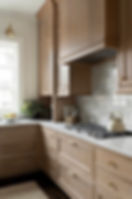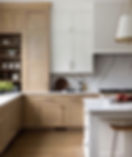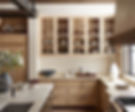The Perfect White Oak Finish
- Corbin Clay
- Feb 6
- 7 min read
Updated: 11 minutes ago
Achieving the perfect white oak cabinet finish that preserves the natural, unfinished look without darkening the wood too much can be tricky. With a few expert tips, we'll cover a range of proven techniques and products, from DIY methods to professional-grade processes, and everything in between. Let's jump right in!

How to Achieve the Perfect Natural White Oak Finish
Why Water-Based Topcoats Preserve the Natural Look
First, let's cover some basics: The simplest way to achieve the natural white oak look, is to use just a water-based clear protective topcoat like varnish or polyurethane. There is a BIG difference in color between oil-based and water-based: oil-based topcoats are often amber to begin with, and push white oak to a more orange tone. Water-based, on the other hand, looks a bit like skim milk and helps to preserve the natural unfinished look on white oak.

This is an important distinction moving forward: a good rule of thumb is water-based finishes have very little color change, oil/solvent-based finishes have quite a bit.
(Here is a link to a deeper dive with professional finishes, if interested in learning more.)
How the Cut of White Oak Affects Grain and Color
Flat-Sawn vs. Rift-Sawn vs. Quarter-Sawn Explained
This refers to how the log was originally milled and will create drastically different grain patterns, especially in oak. There are a lot of important little details like this in custom cabinetry, especially white oak, that need to be considered to ensure you project turns out the way you were hoping (here is a link to our Complete Guide To White Oak Cabinets so you can be familiar and completely prepared for all the decisions).

Flat sawn (also called plain sawn) is the least-expensive and often has wide, arching grain and lots of color variation between the "high" and "low" grain. Rift-sawn is slightly more expensive, has very tight, parallel grain, and is slightly more subtle overall.
Quarter-sawn, often the most-expensive (it's a very wasteful way of milling, unfortunately) is effectively the grain pattern of rift-sawn with little squigly patterns called ray flecking on top of the grain (very popular in Arts and Crafts furniture at the end of the 19th century).
Good, Better, Best
Good: Just A Water-Based Topcoat
This is the simplest and most DIY-friendly (or low-skilled-painter-friendly) approach to preserve the unfinished tone of white oak. Most water-based topcoats will add a little touch of yellow, but nothing like the drastic ambering we see with solvent-based topcoats. Staining light colors on light woods can be especially challenging, so eliminating any stain and just using a topcoat is very simple to do!
Good, professional grade, available-to-the-public topcoats come from brands like General Finishes, Renner, Centurion, and Mohawk.

Pro tip: use (or have your painters use) a sanding sponge in between coats to get a very smooth, luxurious feeling, and easy to clean finish. We like these from 3M.
Better: Renner's Natural Oak Stain, The Best White Oak Stain
If you're wanting to preserve the exact look of unfinished white oak, we'll need to first stain it to counter the yellowing from when the topcoat is applied. The best brand and product is Renner's Natural Oak stain. Here is an excellent video of the entire process from their owner (who's an active member of our Facebook group, if you ever have questions), from surface prep to final sealing, and a direct link to buy everything you need online.
This is the absolute best way to seal white oak without yellowing.

Pro-tip: Staining lighter colors on lighter woods can be especially tricky (it can be hard to see where the stain is and where it isn't) so be sure to flood the surface to ensure complete coverage. You can't "over-stain" something, so don't worry about using too much, you'll wipe all the excess off anyway.
Best: Your Finisher Figures This All Out
Like we've discussed before, if you're paying a professional cabinetmaker top dollar to deliver you a completely finished product, you should have absolutely nothing to do with the process. Any good finisher should be able to look at a few of your inspiration photos and create several samples of a similar look. It is not your responsibility to "give them a stain recipe", Minwax color, or, worst of all, create your own samples (could you imagine if they asked you to create your own door sample? You would laugh and find another cabinetmaker).


If you are working with a proper professional, it is your responsibility to be consistent in the look you're wanting to create. Most pros won't take specific stain recommendations, rather ask to see a few photos and they'll use their tried-and-true system (remember, cabinet finishes are entire systems rather than simply a stain color) to create the look you're wanting, with the confidence they can warranty it for decades.

Honorable Mention: Add A Little White
Using Minwax MW423 Whitewash for a Light, Textured Tone


This is Minwax's MW423 Whitewash stain that pushes a little more white in tone than the lighter brown hue of unfinished oak. While we're not fans of Minwax's topcoats, their stains are alright to use (stains simply change the color of the wood, and offer no additional protection). We recommend using one of the topcoats mentioned above for best results.
Also worth noting: mixing companies' products will most-likely void any warranty (this is why we're so adamant about people using proper finishers for their cabinets), but completely understand a lot of homeowners are stuck having to figure this all out themselves. "Hire a better finisher" isn't really helpful advice if you don't have access to one. Here's hoping this info can be of value.
Consider A Cabinet Manufacturer
For whatever reason, finishing seems to be a complete afterthought in a lot of America's smaller customer cabinet shops. It's without question the biggest headache for so many in our Ask A Cabinetmaker Facebook group and should be a fun and exciting part of the process. If you are not 100% confident in your cabinetmaker's ability to create the look you want, and are early in the process, please consider using a manufacturer.
These companies have state-of-the-art finishing departments and a collection of standard finishes. That means they've been tested and developed for consistency (think the Mercedes paint options at the dealership, as opposed to one-off custom finishes). Some of our favorites are:
Common Questions We Hear About Achieving The Perfect White Oak Finish
1. How do I get a natural white oak cabinet finish?
The easiest way to preserve the light, natural look of white oak is with a water-based clear topcoat like polyurethane or varnish. Unlike oil-based finishes, it won’t darken the wood or add amber tones.
2. Water-based vs oil-based finishes: which is better for white oak?
Water-based finishes preserve the wood’s natural color and add minimal yellowing. Oil-based finishes tend to darken the wood and push white oak toward orange tones, so they’re less ideal if you want a natural look.
3. What’s the best way to seal white oak without yellowing?
Using a neutral stain like Renner’s Natural Oak followed by a high-quality water-based topcoat prevents yellowing and keeps white oak looking unfinished and natural.
4. Can I finish white oak cabinets without staining?
Yes. Applying just a water-based topcoat is a simple, DIY-friendly method to protect the wood while maintaining its unfinished look.
5. What is the best finish for quarter-sawn white oak?
Quarter-sawn oak looks stunning with just a water-based topcoat to preserve its light tone and highlight its unique ray flecking patterns. Professional finishers will use specialized techniques (usually dyes) to even further enhance this unique flecking.
6. What are the best water-based finishes for white oak cabinets?
Top-rated professional-grade brands include General Finishes, Renner, Centurion, and Mohawk. Using a sanding sponge between coats ensures a smooth, luxurious finish.
7. How do I achieve a whitewashed or light oak look?
Minwax MW423 Whitewash stain adds a subtle, textured light tone. For durability, always follow up with a high-quality water-based topcoat.
10. Should I hire a professional finisher or do it myself?
For flawless, long-lasting results—especially for high-end cabinets that often combine veneer and solid wood—hiring a professional finisher is the safest route. They can replicate your desired look with tried-and-true systems and provide a warranty for decades of use.
11. Will switching to rift-sawn white oak give me a more even finish?
Not necessarily. While rift-sawn white oak has a straighter, more subtle grain than flat-sawn, the key to achieving a mellow, even finish is proper finishing, not just the wood cut. Advanced finishing techniques like toning or grain-muting are the best way to reduce color variation and unify the appearance of solid wood and veneer together. Professional finishers can blend differences across panels and achieve a consistent, natural look that simply changing the wood cut cannot.
Expert Advice That Saves You Time and Mistakes
After decades in the industry, we completely understand just how overwhelming this all can be. As a recent member said, "the biggest issue I had during my build was not knowing what I did not know, until it was too late". Additionally, while there are a lot of very talented cabinetmakers... there aren't as many talented finishers.
Having a partner early in the process to help identify red flags, walk you through what the process should look like, and help vet the other professionals on your project is exactly why we created this community.
To help homeowners with free expert advice.
We understand that you're not just building a house, you're creating a home, and every detail has to be perfect. Whether it's our blog or free expert advice in our Facebook group, we're here to help you every step of the way!
